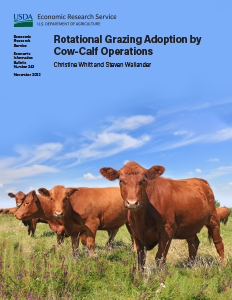Rotational Grazing Adoption by Cow-Calf Operations
- by Christine Whitt and Steven Wallander
- 11/1/2022
Overview
Rotational grazing is a management practice in which livestock are cycled through multiple fenced grazing areas (paddocks) to manage forage production, forage quality, and environmental quality. USDA’s Natural Resources Conservation Service (NRCS) and other organizations promote rotational grazing as an important practice for providing improved environmental outcomes, relative to conventional grazing, in which livestock are not rotated between grazing areas. Despite the breadth of support for rotational grazing, only limited information is available on its prevalence and the variation in how producers implement the practice. This report fills this information gap by providing details on how frequently or “intensively” grazing operations rotate livestock between paddocks, key system characteristics such as average paddock size, and how outcomes such as stocking density and cost relate to system characteristics. The study finds that about 40 percent of cow-calf operations use rotational grazing, but less than half of those are under intensive systems. Rotational grazing is most common in the Northern Plains/Western Corn Belt and Appalachian regions.
Download
-
Entire report
Download PDF -
Report summary
Download PDF

